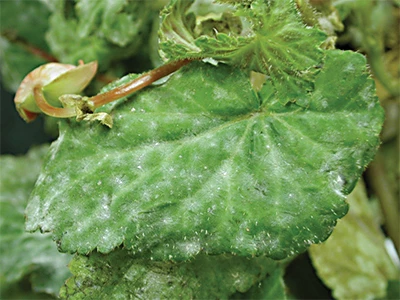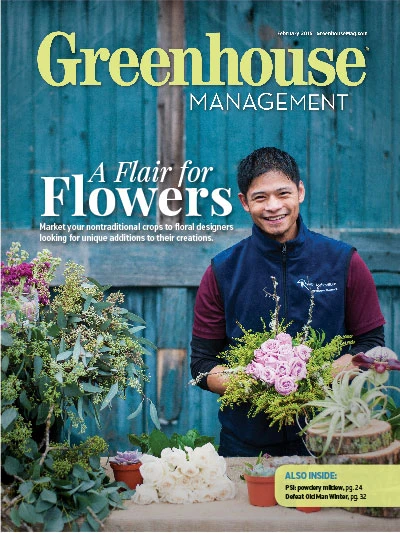
.jpg) Powdery mildew (PM) diseases
Powdery mildew (PM) diseases
Known hangouts: Caused by fungi that grow right across the surface of plants. They anchor to the epidermal cells, penetrate and absorb nutrients from them.
Preferred victims: Many popular ornamentals, notably roses, begonias, African violets, gerberas, hydrangeas and poinsettias, as well as many herbaceous perennials. All above-ground plant parts may be infected, and PM is obvious to any potential customer: Conspicuous round white spots (called colonies) or white coatings appear on the infected plants.
Mode and timing of attack
Airborne spores called conidia spread PM diseases, and populations can develop very quickly. These diseases thrive in high humidity, which is why they are so troublesome in greenhouses.
PM diseases are a problem whenever temperature and humidity permit. They generally do not bother plants during propagation because they are inhibited by free water.
PM can appear during spring bedding plant production or in summer or fall, depending upon the environmental conditions that allow a particular PM fungus to thrive. Powdery mildew on verbenas or petunias may show up in the spring, whereas PM on poinsettias will start to spread and become obvious only in the fall once temperatures fail to reach 86 degrees F.
How to detect and destroy
 Watching for the first signs of powdery mildew is key for cost-effective disease management: Rather than using fungicides preventively through the entire production cycle, a grower with a scouting program can note the beginning of PM and then promptly begin fungicide treatments. Turning lower leaves over on crops known to be susceptible to PM will allow the savvy scout to find the disease before the fungus has spread to cause conspicuous injury on petals or upper leaf surfaces. Over the years, growers may learn which areas of the greenhouse and which crops are first to show powdery mildew, and these can be scouted the closest for the greatest efficiency.
Watching for the first signs of powdery mildew is key for cost-effective disease management: Rather than using fungicides preventively through the entire production cycle, a grower with a scouting program can note the beginning of PM and then promptly begin fungicide treatments. Turning lower leaves over on crops known to be susceptible to PM will allow the savvy scout to find the disease before the fungus has spread to cause conspicuous injury on petals or upper leaf surfaces. Over the years, growers may learn which areas of the greenhouse and which crops are first to show powdery mildew, and these can be scouted the closest for the greatest efficiency.
Rotate to keep PM diseases at bay
There is a bewildering number of powdery mildew fungicides. If your crop is long-term and highly susceptible, you must be especially careful to rotate among different Mode of Action groups (different FRAC codes) to keep from building up fungicide resistance in your crop’s enemy.
One helpful practice is to alternate contact materials or biocontrols (with no resistance problem) with systemic materials (generally prone to triggering resistance in the target fungus). A grower might choose to use biocontrols such as Cease, Companion or Actinovate, or contacts such as Milstop, Kaligreen or a copper, for example, in alternation with materials from the DMI (e.g. Strike, Terraguard) and strobilurin (e.g. Compass O, Pageant) categories.
When rotating, it is important to realize that non-systemic materials tend to last for only one week, while effective systemics may give two weeks’ suppression. Some materials (e.g. Strike Plus) contain DMI and strobilurin ingredients: These should be alternated with contact materials.
Margery Daughtrey is a plant pathologist specializing in ornamentals at Cornell’s Long Island Horticultural Research & Extension Center. She aims to help growers outwit diseases.

Explore the February 2015 Issue
Check out more from this issue and find your next story to read.
Latest from Greenhouse Management
- Happy holidays from the GIE Media Horticulture Group!
- North Carolina Nursery & Landscape Association announces new executive vice president
- Plant Development Services, Inc. unveils plant varieties debuting in 2025
- Promo kit available to celebrate first National Wave Day on May 3
- Applications now open for American Floral Endowment graduate scholarships
- Endless Summer Hydrangeas celebrates 20 years with community plantings
- Invest in silver
- Garden Center magazine announces dates for 2025 Garden Center Conference & Expo





